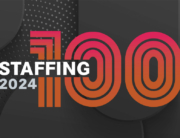Had enough of people hyping social media marketing? It was going to “revolutionize” recruiting, put the customer in charge of your marketing message and eliminate the effectiveness of traditional sales and marketing efforts.
Well, guess what? It didn’t happen. Traditional sales and marketing methods are alive and well in the staffing industry, and the majority of sales are still generated by picking up the phone and getting out to see clients.
But does that mean you can ignore social media? Only if you’re willing to give away business to the competition!
The True Value
Like the telephone, social media is a vital communication tool. It really is radically changing how people gather information and communicate with one another, and while it’s not a silver bullet that will instantly boost sales, it definitely must be a core part of your marketing mix.
Here are ways social media is being used in staffing.
Sales lead generation. Social media is proving to be an ideal mechanism to find, attract and connect with employers and job seekers. Whether it’s through LinkedIn Groups, Twitter searches, or sponsored stories on Facebook, social media is excellent for building your prospect base. When used in conjunction with SEO and landing pages on your website, social media can consistently generate sales inquiries and candidate applications.
Networking and research. Never before has it been easier to find people. Whether you’re searching for the right decision maker to call or sourcing the perfect candidate, LinkedIn, Facebook, Twitter and even search engines can all be used to locate precisely the people you want to meet. Then you can use social messaging like InMail and Twitter direct messaging to get referrals and/or make initial introductions.
Market research. Tools like HootSuite, TweetDeck, Google Alerts and Social Mention make it easy to monitor trending topics and research specific insights about your industry and local market. Social listening services like Yelp and Get Satisfaction enable you to keep tabs on what people are saying about your business and your competition.
Branding. Ten years ago, it cost a lot of money to get your message in front of the right people. Today, you can create a blog post, video or podcast and easily share it with tens of thousands of potential clients using tools like Share This, online PR services and search engine optimization.
Content aggregation. A big key to success in social marketing is sharing great content — distributing ideas that your clients, prospects and candidates will find interesting. While you can write everything yourself, it’s often easier and more cost-effective to augment your own content with ideas you source from others. Ideally, your content will consist of 60 percent to 70 percent original information with the rest sourced through tools like LinkedIn Today and subscribing to RSS feeds from industry publications and the blogs of people who are thought leaders and industry experts.
A word of caution! You cannot simply take other people’s content and add it to your website, blog or social profiles. That’s a copyright violation. You can, however, provide a synopsis or comment on content you find elsewhere and then link to the source article from your blog or website. You can also directly share links to third-party content through social sharing, which can be good for personal branding but far less useful for lead generation.
The Essential Tools
The biggest challenge with social marketing is that it seems so overwhelming. There are literally thousands of tools, networks, services and consultants available to help with your marketing. But social marketing doesn’t have to be hard or overly time consuming. Here’s how you can get started.
Your website. You may not think of your website as a social media tool, but it should be the hub of your online marketing efforts. Your website should be a conduit for sharing ideas and capturing sales leads. Every staffing website should include: updated job listings with an online application, the ability for candidates to request job agents, high-value content that addresses the interests and pain points of your clients and candidates, regularly updated news, PR and insights (see “blog,” below), and landing pages that promote specific events or content while capturing contact information.
Blog. Ten years ago, blogging was a novelty. Five years ago, it started to enter the mainstream. Today, a blog is an essential marketing tool. A blog (that gets updated at least once per week) is essential for search engine optimization, and it provides a steady stream of content that your sales team can leverage in their social media selling efforts.
LinkedIn. Is there any staffing company that doesn’t already rely on LinkedIn for prospect research and candidate sourcing? But these activities are really just a start, and to fully leverage the power of LinkedIn, your sales team should be spending 15 to 30 minutes per day on activities like content sharing via LinkedIn groups and direct messaging, making status updates, building their contact network, and asking and answering questions (in Groups and LinkedIn Answers).
Facebook. For most staffing firms, Facebook is more of a recruiting tool than a sales tool (firms in creative staffing may take exception to this comment). Facebook is an ideal channel to show off your company culture and connect with your candidates on a more personal level. While you can promote jobs on Facebook, do so sparingly. Instead, use Facebook to share pictures, stories and videos that highlight the great companies you serve and the talented people you place. You might also want to experiment with Sponsored Stories and PPC marketing on Facebook because it allows you to do very targeted marketing.
Twitter. Your firm should use Twitter in a few different ways. First, distribute all your jobs and blog posts via Twitter (you’ll need an RSS feed of the jobs and from your blog to do this). A lot of people use Twitter as a search engine, so you want to make sure your jobs and ideas can be found. Second, use a tool like HootSuite or TweetDeck to monitor searches about your company, competitors, employers you want to follow and industries you serve. Twitter is a great research tool. Finally, seek out and follow people who are decision influencers in your local market and/or industries you service. You can start to develop relationships with people who are thought leaders and decision influencers, and that will greatly improve referrals of both clients and candidates.
SEO. While search engine optimization is not traditionally seen as a form of social media, recent changes in the way Google indexes web pages and displays search results have caused marketers to radically rethink their approaches to SEO. Gone are the days of filling your pages with keywords. Instead, you need to find ways to maximize followers, links/likes and retweets of your content. Google rewards websites that are socially relevant, and the more social connections people have with your firm and your content, the more highly your site will rank for the kinds of content you produce, which will in turn drive significantly more traffic to your website.
Maximize Sales Leads
Once you’ve mastered the fundamentals and have created a content and social marketing machine, it may be time to up your game with rich content. Rich content is highly effective at attracting staffing buyers and job seekers. Some of the channels to consider include:
YouTube. Americans are avid video consumers, and YouTube is the No. 2 search engine. Videos can be highly effective for sharing how-to information, positioning your firm as a thought leader and ensuring your firm’s core story is told with a consistent voice and message. YouTube videos can be embedded into your website, company blog or social profiles. LinkedIn now makes it really easy to add videos and other rich content to your company and personal profile.
SlideShare. When you need to educate people about your services, PowerPoint is the traditional workhorse. And when you want to share that presentation with others, SlideShare is a powerful platform for getting your content in front of others. SlideShare is the world’s largest professional content sharing community with more than 60 million visitors a month, including more C-level traffic than any other network.
Webcasting. Employers, and specifically HR managers, are always hungry for ideas. They want to learn more about how to do their jobs effectively, and webcasts (or webinars) are one of the most effective ways to provide educational content. Services like GoToWebinar even allow you to record webinars so that you can leverage each presentation for months or even years on your website.
Pinterest. If you thought Pinterest was just for fashion, home decor and other visual products, think again. Pinterest has been the fastest-growing social network of all time, and it’s a great way to engage clients and candidates with compelling visual content. But as a staffing firm, what visual content do you have? This is where you have to get creative. You might create infographics about ways to use staffing, samples of creative and unusual résumé formats, or even create contests where you ask clients to share pictures that show off their corporate culture or present the office most in need of a makeover. However, the easiest way to use Pinterest is as a visual blog — to pin pictures from your blog posts to a Pinterest board that will drive people back to your blog.
New Resources
If I somehow have not overwhelmed you yet with all the things staffing firms can do with social media, here’s a quick list of a few new and interesting sites and technologies to help you make the most of your social media marketing efforts:
Social Media Examiner. A great blog that follows all things social media (my personal favorite source for insights and inspiration).
Newspaper.li. Build your own custom online newspaper based on RSS feeds of content that’s relevant to your clients and candidates.
HootSuite. Makes social listening, content sharing and analysis of your results a lot easier.
GaggleAMP. A tool that will allow you to leverage the networks of your sales reps and recruiters to increase distribution of your content.
Google Reader. OK, this is not new, but it’s an essential tool for aggregating ideas from all the blogs and websites you follow.
Instagram. Great for creating “shareworthy” graphics from your phone.
Buffer. Lets you schedule your posts and tweets to ensure more consistent sharing.
LinkedIn Projects. Show off pictures of your work, PDFs, PowerPoints and other branding documents in your employees’ LinkedIn profiles.
Quozio. A fun little tool for creating pinable graphics from quotations or text in your blog posts and website.
While I don’t think social media replaces traditional staffing sales, I am fully convinced that it makes sales reps and recruiters more productive. It opens the door for more meaningful conversations and better educates the market about the real value of staffing. It also gives your reps much more productive ways to use their time than “spinning the dial.”
– See more at: http://www.staffingindustry.com/site_member/Research-Publications/Publications/Staffing-Industry-Review/Archive/March-2013/Don-t-Ignore-It#sthash.bD15wh46.dpuf







